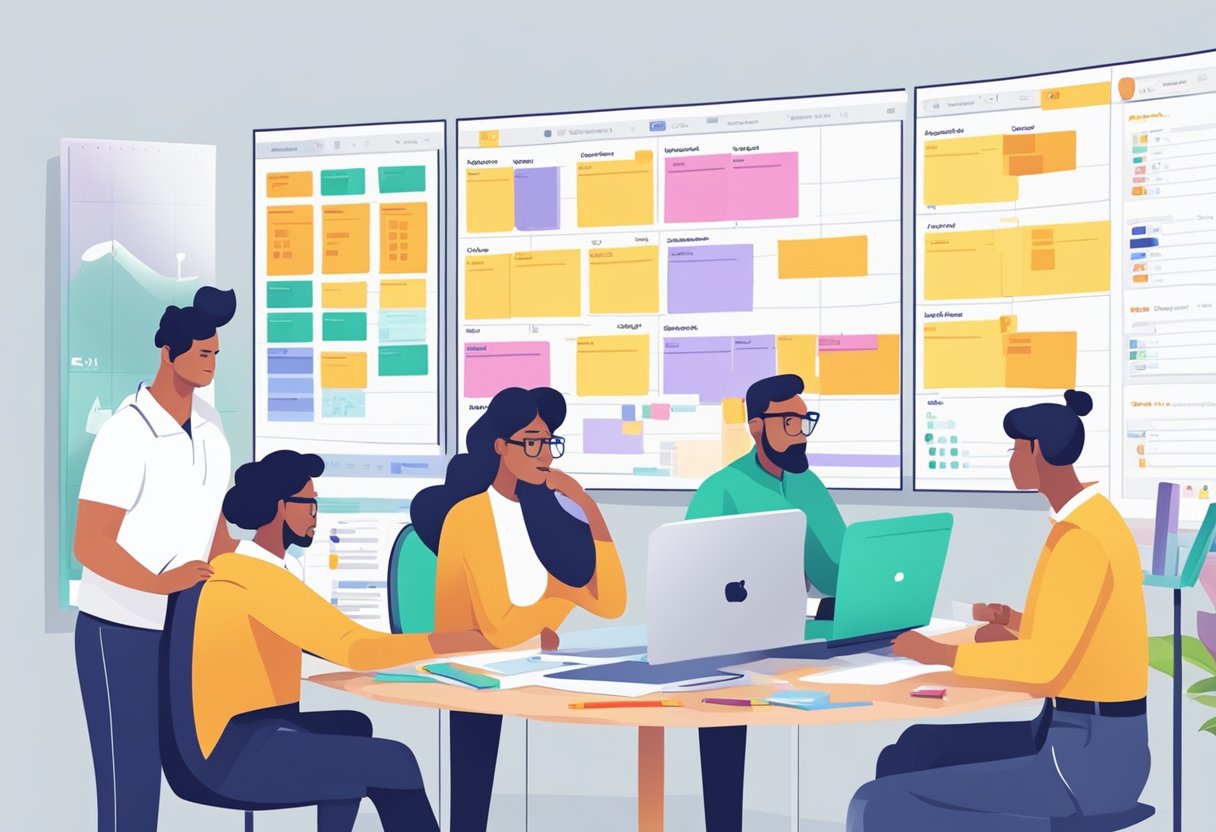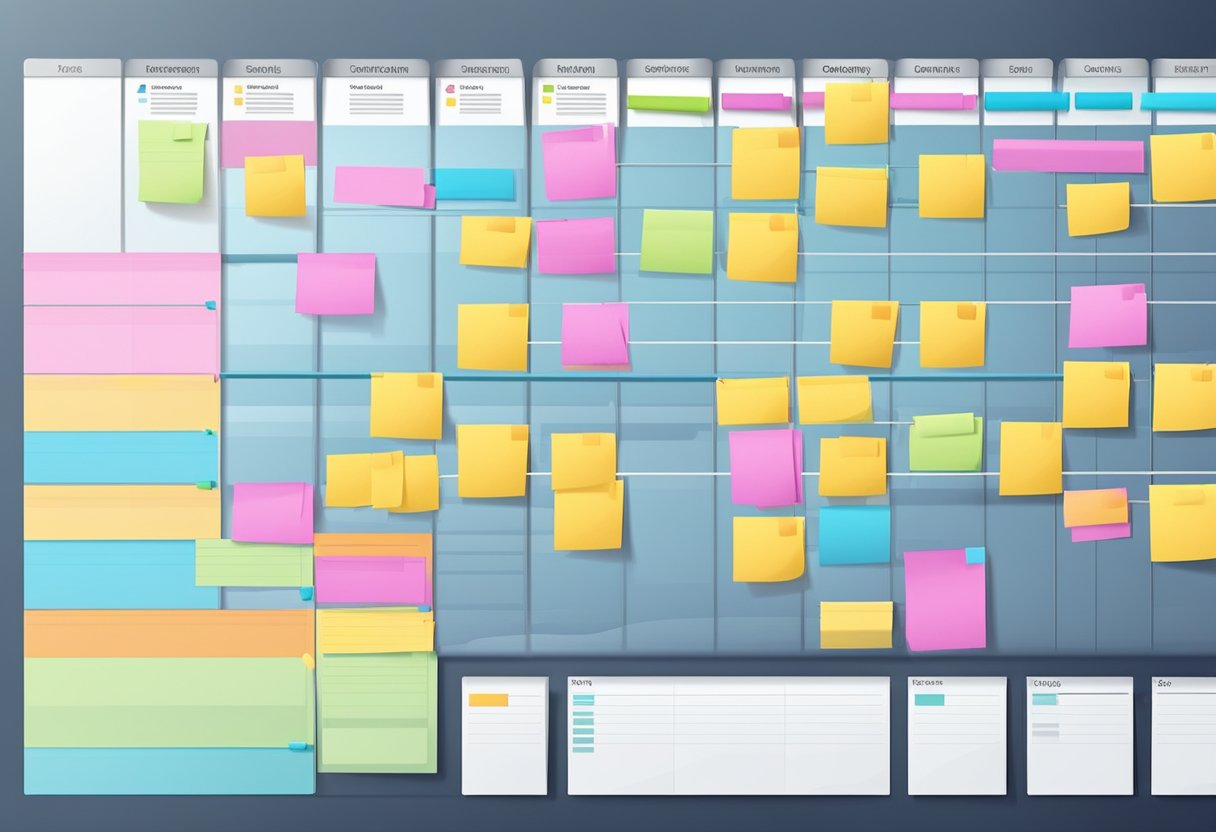Effective project management is the cornerstone of successful project delivery. It is a discipline that involves the careful planning, organizing, and managing of resources to bring about the successful completion of specific project goals and objectives.
Techniques in project management are numerous and they vary based on the industry, the nature of the project, and the preferences of the project manager or organization involved. A project manager must skillfully navigate through various phases such as initiation, planning, execution, monitoring, and closing to ensure the project meets the desired outcome.

Project management is not a static field; it has evolved significantly over time with the development of new methodologies and tools. Traditional methods like Waterfall are increasingly supplemented or replaced with agile practices like Scrum or Kanban to accommodate the dynamic nature of modern projects. Each methodology introduces distinct principles and practices for planning, scheduling, executing, and evaluating projects. Moreover, comprehensive risk and change management is crucial to mitigate unforeseen issues and steer the project back on course. The project manager must also foster a collaborative environment and maintain clear lines of communication to achieve the project’s objectives effectively.
Key Takeaways
- Project management techniques are vital for achieving project objectives efficiently.
- Methodologies and tools in project management continue to evolve to meet the changing needs of projects.
- Successful project management hinges on thorough planning, risk management, and effective communication.
Project Management Fundamentals
Project management fundamentals encompass a structured framework that guides the completion of projects from inception to closure. This framework ensures that objectives are met and stakeholders remain engaged throughout the project.
Project Life Cycle
The Project Life Cycle consists of four primary phases: Initiation, Planning, Execution, and Monitoring and Control, concluding with Closure. Each phase addresses different activities within the project management process.
- Initiation: The project begins with defining the project scope and developing the project plan, which outlines the approach to be taken.
- Planning: In this phase, detailed planning, including a Work Breakdown Structure (WBS), is developed to organize tasks and responsibilities.
- Execution: The project team carries out the project plan, utilizing resources efficiently to meet objectives.
- Monitoring and Control: The project manager oversees progress and adjusts plans as necessary to keep the project on track.
- Closure: In the final phase, the project is formally closed and the deliverables are handed over.
Project Objectives and Goals
Defining project objectives and goals is critical to project success. Goals must be specific, measurable, attainable, relevant, and time-bound (SMART).
- Project Objectives: Should align with business objectives and be clear to all stakeholders.
- Goals: Serve as benchmarks for measuring project progress and success.
Stakeholder Engagement
Stakeholder Engagement involves identifying all stakeholders and understanding their influence and interest in the project.
- Stakeholder Management: It includes strategies for communication and involvement that cater to stakeholders’ needs and expectations, effectively managing their input and concerns throughout the project’s life cycle.
Team and Resource Planning
Effective Team and Resource Planning is essential for timely project completion within budget.
- Project Team: Building a skilled team with clear roles and responsibilities is key.
- Project Resources: Precise resource management plans ensure that necessary resources are available as needed.
In each of these areas, the use of tools, techniques, and industry best practices can greatly enhance the performance and outcome of a project.
Project Management Methodologies
Selecting the appropriate project management methodology is crucial for the successful execution of any project. Each methodology possesses unique principles and practices tailored to different types of projects and teams.
Agile Project Management
Agile project management is a flexible approach that accommodates change and requires a high degree of collaboration. It focuses on delivering small, workable portions of the project, known as sprints, in a short timeframe. Notable frameworks within agile include Scrum and Kanban, with Scrum featuring roles like Scrum Master and events such as daily stand-ups to promote communication and quick adaptation to changes.
Waterfall Project Management
The Waterfall method is a traditional project management approach characterized by a sequential process. This method is well-structured, with each phase of the project leading into the next, and is preferred when changes are not anticipated. Detailed documentation and upfront planning form the backbone of Waterfall project management, making it suitable for projects with clear, fixed requirements.
Critical Path Method (CPM)
Critical Path Method (CPM) is a step-by-step project management technique that identifies critical and non-critical tasks with the aim to prevent timeframe delays and process bottlenecks. It involves mapping out every key task that is essential to a project’s completion and calculating the minimum timeline needed to complete each task, determining the project’s overall duration.
PRINCE2 and PMI Standards
PRINCE2 (Projects IN Controlled Environments) and the PMI (Project Management Institute) are organizations offering certifications and standards in project management. They provide frameworks that incorporate established principles, processes, and themes to ensure project management is conducted in a controlled environment. Both the PRINCE2 certifications and PMI’s PMP (Project Management Professional) certification are widely recognized and sought after in the industry for their comprehensive coverage of project management knowledge and best practices.
Planning and Scheduling Techniques

Effective project management hinges on robust planning and scheduling techniques that provide a clear path from project initiation to completion. These methodologies allow for detailed task organization and help managers visualize timelines and dependencies.
Work Breakdown Structure (WBS)
A Work Breakdown Structure (WBS) serves as the foundation for comprehensive project planning. It involves deconstructing the project into smaller, more manageable components, generally referred to as deliverables. Successive subdivision continues until the project is divided into workable tasks. This hierarchy reflects the task prioritization and allows for easier management and allocation of resources. Here’s an example of what a simple WBS might look like in table format:
| WBS Level | Description | Deliverables |
|---|---|---|
| 1.0 | Project | Final product |
| 1.1 | Phase 1: Initiation | Project charter |
| 1.2 | Phase 2: Planning | Project plan, WBS |
| 1.3 | Phase 3: Execution | Product components |
| 1.4 | Phase 4: Monitoring | Progress reports |
| 1.5 | Phase 5: Closing | Final deliverable, documentation |
Gantt Charts and Timelines
Gantt Charts represent the project schedule visually, mapping out the project tasks on a timeline. They are instrumental in illustrating the start and end dates of each task and the task dependencies that dictate the sequence of operations. Each bar on the Gantt chart corresponds to a task, with its length representing the task duration. Key milestones are often highlighted to signal major progress points. For example:
| Task Name | Start Date | End Date | Duration | Dependencies |
|---|---|---|---|---|
| Market Research | Jan 10 | Jan 24 | 2 weeks | None |
| Product Design | Jan 25 | Feb 14 | 3 weeks | Market Research |
| Prototype Testing | Feb 15 | Mar 01 | 2 weeks | Product Design |
By utilizing Gantt charts, project managers can concurrently track multiple aspects of a project’s progress and adapt the project timeline as necessary, ensuring that the team remains informed and efficient throughout the lifecycle of the project.
Execution and Monitoring

In project management, the “Execution and Monitoring” phase is crucial for guiding a project from plan to completion. This phase relies on well-defined metrics and continuous improvement methodologies to ensure project progress aligns with goals.
Agile Implementation
Agile methodology emphasizes adaptive planning, evolutionary development, and early delivery. It involves iterative work cycles known as sprints, wherein the sprint backlog—a list of planned tasks—is tackled. The Scrum Master facilitates these sprints, working with teams to implement changes quickly, based on feedback loops and project progress measurements. Documentation is continuous, ensuring that everyone is informed.
Kanban Workflow Management
Kanban enhances project execution through visual workflow management. A physical or digital Kanban board visually tracks tasks, providing real-time project progress updates. This system encourages continuous improvement as team members pull tasks from the backlog as capacity allows, helping maintain a steady workflow and minimize bottlenecks.
Quality Assurance
Quality assurance (QA) in project management is the process of verification and quality control to ensure project outcomes meet the required standard. Metrics are crucial for QA, providing objective criteria by which project quality can be assessed. Effective QA involves consistent feedback loops, allowing for the immediate rectification of any issues the process uncovers. The documentation generated within this process serves as an essential tool for tracking quality metrics and maintaining accountability.
Risk and Change Management

Effective project management hinges on the proactive identification and handling of risks as well as the meticulous management of changes. It ensures that project risks don’t derail the timeline, and that modifications are implemented smoothly, keeping the project aligned with its original requirements.
Risk Assessment and Mitigation
The first step in managing risks is to identify potential project risks, which can include budget overruns, scope creep, and resource unavailability. Once identified, project managers must conduct thorough risk assessments. This involves categorizing the risks as high, medium, or low impact and likelihood, as demonstrated in the risk matrix below:
| Risk Impact | High | Medium | Low |
|---|---|---|---|
| High Likelihood | Critical Risk | Significant Risk | Moderate Risk |
| Medium Likelihood | Significant Risk | Moderate Risk | Low Risk |
| Low Likelihood | Moderate Risk | Low Risk | Minimal Risk |
Mitigation strategies are then developed for each identified risk, ranging from avoidance and transfer to acceptance and contingency planning. Project managers should document all possible mitigative actions and periodically review the risk landscape, updating the risk matrix and strategies as the project progresses.
Change Control Processes
Change control is vital for managing project requirements and ensuring that changes are not implemented haphazardly, which can introduce new issues. A structured change control process involves:
- Documentation: Any change request must be documented, detailing the nature of the change and its potential impact on the project.
- Analysis: The change is analyzed in terms of its necessity, impact on schedule, cost, and other project constraints.
- Approval: Changes must be reviewed and approved by relevant stakeholders or a change control board before implementation.
- Implementation: Once approved, the change is carefully implemented, with the project manager overseeing the process to ensure alignment with the project’s goals.
- Review: Post-implementation, a review occurs to ensure the change has achieved its intended objectives without introducing new risks or issues.
A project manager acts confidently, utilizing corrective actions to address any issues that arise from changes to the project. They directly manage project risks and changes with a clear understanding that risk management and change management are interrelated processes that require constant attention.
Collaboration and Communication

Effective collaboration and communication are vital for the success of any project. They ensure that all stakeholders are aligned, and that the project team can work together efficiently.
Effective Team Collaboration
Team collaboration hinges on establishing clear roles and responsibilities within the project team. Efficient collaboration tools, like shared workspaces or project management software, allow team members to update others on their progress and share essential resources. Regular meetings facilitate real-time problem solving and decision-making. Structured collaboration ensures that project updates are disseminated in a timely manner and that efforts are well-coordinated.
Communication with Stakeholders
Clear and consistent communication with stakeholders is crucial for building trust and ensuring project alignment. This involves formulating a Stakeholder Management plan that outlines how and when stakeholders will be informed. Whether through formal reports or regular updates, stakeholders should always have a clear understanding of project progress. Feedback mechanisms should be put in place, enabling stakeholders to contribute their insights, which can be invaluable for project success.
Project Documentation and Reporting
Keeping detailed documentation throughout the project lifecycle is a key aspect of project management. Documentation provides a historical record, aids in ensuring compliance, and assists future project planning efforts. Project reporting should be systematic, with always up-to-date status reports that include completed and upcoming milestones, encountered obstacles, and financial overviews. This ensures that everyone involved has access to the most current project information.
Project Completion and Evaluation

Project completion and evaluation are critical phases that encapsulate the finalizing of deliverables and the reflective process of analysis post-project to glean valuable insights for future endeavors.
Finalizing Project Deliverables
At the end of a project, it is essential to ensure that all project deliverables meet the set criteria and standards agreed upon at the outset. Each deliverable should be thoroughly checked and verified for adherence to specifications, functionality, and quality. Teams should carefully document project closure aspects, which typically include:
- Handover documents
- Operational guides
- Maintenance schedules
Final approval from stakeholders signifies the official acceptance of project results and triggers the transition from active development to operational status.
Post-Project Analysis
Once a project has concluded, conducting a review and evaluation is crucial. This process often involves compiling a “lessons learned” document, which records successes, challenges, and areas for improvement. Key components of the post-project analysis may include:
-
Lessons Learned: Documenting what worked well and what didn’t, in order to inform future projects.
-
Project Completion: Evaluating whether the project met its objectives, was delivered on time, and stayed within budget.
-
Quality of Deliverables: Assessing the quality of the final products or services delivered.
This phase is instrumental in enhancing an organization’s project management capabilities and ensuring continuous improvement.
Tools and Technologies

Effective project management relies on a suite of tools and technologies designed to enhance collaboration, streamline workflows, and manage resources. Project management software, such as Asana, Trello, and Jira, provides platforms to track progress, assign tasks, set deadlines, and manage the project’s lifecycle. The choice of software often depends on the specific needs of the project and the methodologies employed.
| Feature | Benefit |
|---|---|
| Task Assignment | Enables managers to assign tasks to team members with clarity on expectations. |
| Progress Tracking | Allows for monitoring the status of various tasks and milestones. |
| Resource Allocation | Facilitates optimization of resource distribution and workload management. |
In software development, the integration of version control systems like Git with project management tools helps in tracking changes, reviewing code, and managing contributions from different team members, often concurrently.
Project management frameworks, such as Agile, Scrum, or Kanban, can be implemented within these tools to provide structure and facilitate iterative development. Each offers unique features:
- Agile frameworks focus on adaptability and customer feedback.
- Scrum emphasizes on time-boxed iterations known as sprints.
- Kanban provides a visual workflow to manage work in progress.
Selecting the appropriate tool and framework is crucial; it must align with the project’s scope, complexity, and team size. Ensuring that the technology provides the necessary features for effective management is essential for project success.
Frequently Asked Questions

This section addresses common inquiries related to project management, providing concise insights into methodologies, tools, and adaptation across various industries and project types.
What are the critical stages in the project management lifecycle?
In the project management lifecycle, the critical stages include initiation, planning, execution, monitoring and controlling, and closure. These stages form a structured framework for leading a project from ideation to completion.
Which software tools are essential for effective project management?
Essential software tools for effective project management often encompass task scheduling, resource allocation, budget management, and collaboration platforms. Tools like Microsoft Project, Asana, Trello, and JIRA are frequently utilized for these purposes.
How do agile and waterfall methodologies differ in project management?
Agile and waterfall methodologies differ primarily in their approach to execution. Agile is iterative and flexible, focusing on customer collaboration and responsiveness to change. In contrast, the waterfall model is linear and sequential, emphasizing meticulous planning and documentation.
What are some examples of where technical processes intersect with project management?
Technical processes intersect with project management in areas such as software development, engineering, and IT infrastructure deployment. Here, project managers must integrate technical tasks with timelines, risk assessments, and stakeholder communication.
How can project management techniques be adapted for software development projects?
For software development projects, project management techniques adapt by embracing iterative cycles, incremental deliveries, and close stakeholder engagement, often through the use of agile methodologies to accommodate the dynamic nature of software design and coding.
What project management approaches are most successful in construction projects?
In construction projects, successful project management approaches usually include a strong emphasis on risk management, detailed upfront planning, frequent on-site coordination, and rigorous adherence to safety and regulatory compliance, often leaning towards the waterfall methodology for its structure.















